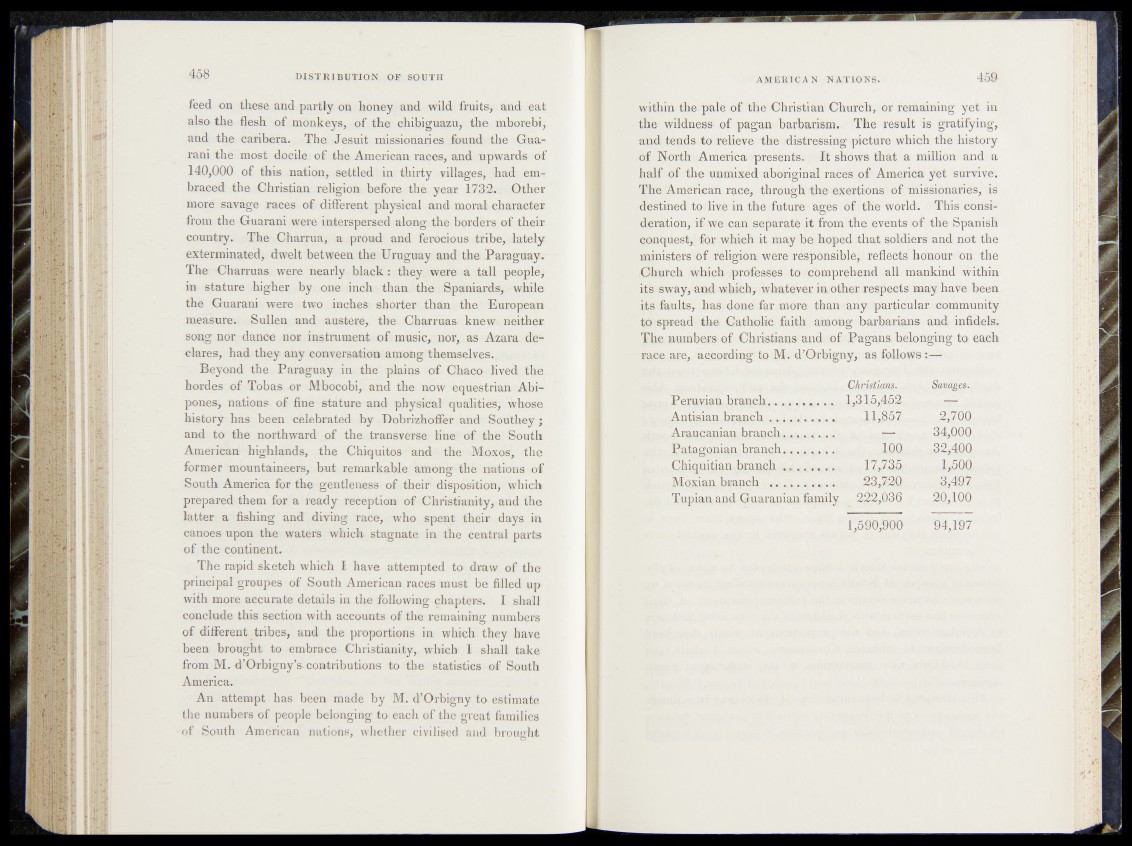
feed oil these and partly on honey and wild fruits, and eat
also the flesh of monkeys, of the ehibiguaau, the mborebi^
and the earibera. The Jesuit missionaries found the Guarani
the-most docile of the American races, and upwards of
140,000 of this nation, settled in thirty villages* had embraced
the Christian religion before the year 1732.. Other
more savage races of different physical and moral character
from the Guarani were interspersed along the borders of their
country. The Charrua, a proud and ferocious tribe, ^lately
exterminated, dwelt between the Uruguay and the Paraguay.
The Charruas were nearly black: they, were a tall people,1
in stature higher by one inch than the1 Spaniards* while
the Guarani were two inches shorter than the European
measure. Sullen and austere, the* Charruas, knew neither
song nor dance nor instrument of music, nor, as Azam declares,
had they any conversation among themselves..
Beyond the Paraguay in the plains of Chaco Ived th i
hordes of Tobas, or Mbocobi, and the now equestrian Abi-
pones, nations of fine stature and physical qualities, whose
history has been celebrated by Xfobrizhoffer and Southey ;
and to the northward of the transverse line of thellfoufh
American highlands, the Chiquitos and the Mo>x©s, the
former mountaineers, but remarkable among the nations of
South America for the gentleness of their disposition, which
prepared them for a ready reception of Christianity, and the
latter a fishing and diving race, who spept their days in
canoes upon the waters which stagnate in the central parts
of the continent.
The rapid sketeh which I have attempted to draw of the
principal groupes of South American races must be filled up
with more accurate details in the following chapters. I shall
conclude this section with accounts of the remaining: numbers
of different tribes, and the proportions in which they have
been brought, t© embrace Christianity, which I shall take
from M. d’Orbigny’s.contributions to the statistics of South
America.
An attempt has been made by M. d’Orbigny to estimate
the numbers of people belonging to each of the great families
of South American nations, whether civilised and brought
within theqaale ofothe^Christian Church, or remainii|^; yet in
the wildness of pagan barbarism. The result is gratifying,
and tends to relieve the ^ds^pessingfptt the history
of iKbrth America^pTisenf^ M It shows that a million and a
half of the unmixed aboriginal, races of America yet survive!.
Th& American race,..through the* exertions of missionaries, is
destined tonlivae imthe^futnifei WotMC' This consideration,
if we*can separated# from the.events of ithfe Spanish
conquest, for which it, may be hoped thafesj@ldiers and not thi|s
ministem of religion were responsible^ reflects! honour on the
♦phiirch which--Aprofesfes to;#pbmpr^y^|iiiil mankind within
its sway, and which, whatever in other respects may have been
its faults, has donefar more than1.any particularf'CommUnity
to spread the Catholic faith among barbarians and infidels.
The numbers of Christians and of Pagans, belonging to eaeh
raee ate, aocording to M. d’Qrbigny, as foUoWs ~
• QAristjans,.gg
Peruvian, branch.,. . . . . . . . . . ,
Anriskn, branch, j j . . . . . . 2,.70/i
Arannapian branch d - • * ,ih , 34J]QP
Patagonian branch.. . . . , * ... XQQ ;,J ;:
jQhiqwiliftn branch . . . . . .
Moxian branch 3,497
Tupian and Guaranian family ^ 223,03fo; 2^,100
H UH • 94,197